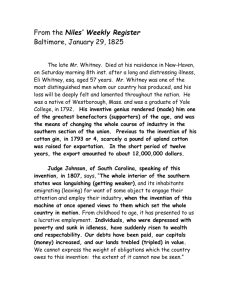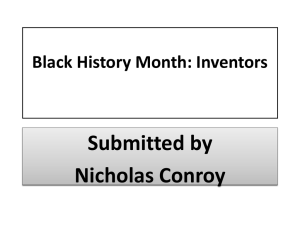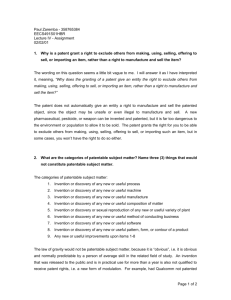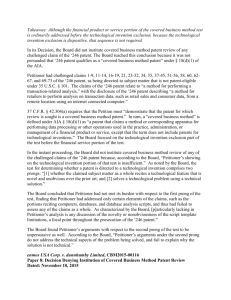Kate Blankenship April 28th, 2011 Modern western society`s self
advertisement
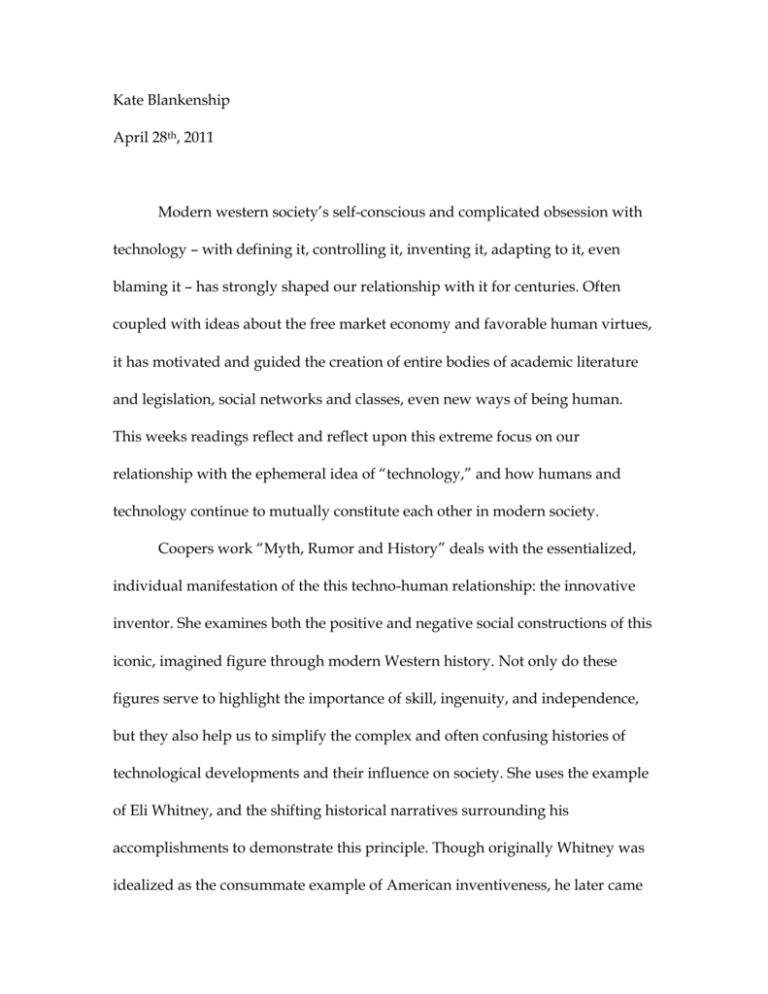
Kate Blankenship April 28th, 2011 Modern western society’s self-conscious and complicated obsession with technology – with defining it, controlling it, inventing it, adapting to it, even blaming it – has strongly shaped our relationship with it for centuries. Often coupled with ideas about the free market economy and favorable human virtues, it has motivated and guided the creation of entire bodies of academic literature and legislation, social networks and classes, even new ways of being human. This weeks readings reflect and reflect upon this extreme focus on our relationship with the ephemeral idea of “technology,” and how humans and technology continue to mutually constitute each other in modern society. Coopers work “Myth, Rumor and History” deals with the essentialized, individual manifestation of the this techno-human relationship: the innovative inventor. She examines both the positive and negative social constructions of this iconic, imagined figure through modern Western history. Not only do these figures serve to highlight the importance of skill, ingenuity, and independence, but they also help us to simplify the complex and often confusing histories of technological developments and their influence on society. She uses the example of Eli Whitney, and the shifting historical narratives surrounding his accomplishments to demonstrate this principle. Though originally Whitney was idealized as the consummate example of American inventiveness, he later came under scrutiny and criticism for betraying these very principles. Despite the fact that the stories told about Whitney changed over time, the high regard in which the qualities he represented were held did not. Although historians of technology have now come to realize that the process of invention involves many people working in conjunction over time, myths such as that of Eli Whitney still hold significance for the broader American public because they represent deep and idealized “truths” about human interaction with technology that continue to have social value. Continuing this theme of the relationships between technology and society, In “Social Construction of Invention Through Patent Management,” Cooper examines the modern history of patents, and how they changed the understanding of technology as well as how they were changed by it. Because of the shifting powers and responsibilities of the patent office, as well as the variability among its employees, the ways in which the concepts of “invention” and “originality” were defined did not remain static, although they were presented as ostensibly objective. The interconnections between technological inventions, the patent system and the market economy also had significant consequences for the modern understandings and usages of technology, which came to be seen as an avenue for profit, protected and supported by the existence of patents. Inventiveness was not the pinnacle of technological achievement, but the ability to effectively deploy one’s inventiveness in the pursuit of economic success. This mutability of the social definition of technology is demonstrated by Cooper in her examination of the extended bureaucratic dialogues and negotiations between Thomas Blanchard, the US government, the legal system and other craftsmen/inventors, all centering around his patent of the irregular lathe and wood-bending machine. In contrast to the purported “objectiveness” of the patent system, Cooper demonstrates the true subjectivity of the modern definition of technology and invention and their purposes in society. The realization that not only do we influence technology but that technology influences us in unexpected and unpredictable ways is analyzed by Sungook Hong in his article “Unfaithful Offspring.” The author takes three examples of the intersection of society with technology and attempts to explain their “unpredictable” consequences, thus questioning the conception of technologies as autonomous agents that act outside of human control, an essential part of actor network theory. By examining the Triode, the NC machine, and the Internet, the author shows that it is in reality, a failure to fully acknowledge the complexity and impact of the social context in which technology develops that lead scholars to characterize technology as “out of control.” He believes that this reaction stems from a sense of a loss of control and autonomy in regards to technology, some of which is based in reality. But because humans seek to exonerate themselves of responsibility for the social consequences of certain technologies, they have gone too far in assigning technology a completely autonomous nature. Although all of the articles referenced make strong arguments about and examinations of the human relationship with technology and invention, they themselves also reflect this relationship. Only a society in which technological skill, innovation and practicality (regardless of how these characteristics are specifically defined) are highly valued and thoroughly incorporated into the social structure would produce articles like “Myth, Rumor and History” and “Social Construction of Invention Through Patent Management.” And only a group of people with deep-seated concerns and anxieties about the impact and power of technology in their lives would spend so much time creating the theories about technological control and autonomy against which Hong reacts in “Unfaithful Offspring.” Overall, works such as these not only provide critical analyses of the modern human obsession with technology, but provide examples of this obsession through their very existence.
![Introduction [max 1 pg]](http://s3.studylib.net/store/data/007168054_1-d63441680c3a2b0b41ae7f89ed2aefb8-300x300.png)
